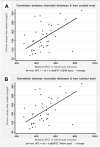Effects of Ketoconazole on the Clinical Recovery in Central Serous Chorioretinopathy
- PMID: 35711967
- PMCID: PMC9192783
- DOI: 10.2147/OPTH.S368427
Effects of Ketoconazole on the Clinical Recovery in Central Serous Chorioretinopathy
Abstract
Purpose: Patients with hypercortisolism have been associated with a higher prevalence of the pachychoroid spectrum including central serous chorioretinopathy (CSCR), which may explain the inconsistency of therapeutic responses of the mineralocorticoid receptor antagonist because hyperaldosteronism has rarely been detected in patients with CSCR. Therefore, this study aimed to evaluate the effects of ketoconazole, the first-line cortisol inhibitor, on the resolution of subretinal fluid (SRF) in CSCR and to analyze correlations between choroidal thickness and steroid hormones.
Patients and methods: This retrospective cohort study included 41 naïve CSCR eyes of 41 patients categorized into control (20 eyes) and treatment (21 eyes) groups. Patients in the treatment group were administered oral ketoconazole at a daily dose of 400 or 600 mg for 3-6 weeks. At week 12, rescue laser therapy was applied to patients exhibiting persistent SRF. Thus, a survival analysis was performed to determine the time interval from presentation to clinical resolution of SRF. Secondary outcomes consisted of eyes with persistent SRF and factors affecting the therapeutic response.
Results: The mean 24-hour urinary free cortisol (UFC) levels were elevated at 181 ± 70 and 150 ± 68 µg/day (range: 20-150) in the treatment and control groups, respectively (p = 0.21). After controlling for age and gender, baseline UFC levels were significantly associated with choroidal thickness in both eyes (p < 0.05). Ketoconazole significantly increased the CSCR resolution with the median time to resolution of 7 vs 16 weeks (p < 0.01) and decreased the proportion of eyes receiving rescue therapy at 12 weeks (23.8% vs 50%; p = 0.01). Prolonged CSCR durations were likely found in elderly patients with thick choroids in fellow eyes.
Conclusion: Patients with CSCR showed elevated glucocorticoids, which further correlated with their choroidal thickness. Using cortisol blockers may shorten the duration of existing SRF.
Keywords: choroidal thickness; cortisol; mineralocorticoid receptor antagonist; pachychoroidopathy.
© 2022 Chantarasorn et al.
Conflict of interest statement
The authors report no conflicts of interest in relation to this work. No financial disclosures or conflicting relationship exists for any authors. Oral ketoconazole is not yet approved for the treatment of CSCR.
Figures




Similar articles
-
Oral Mineralocorticoid-Receptor Antagonists: Real-Life Experience in Clinical Subtypes of Nonresolving Central Serous Chorioretinopathy With Chronic Epitheliopathy.Transl Vis Sci Technol. 2016 Mar 4;5(2):2. doi: 10.1167/tvst.5.2.2. eCollection 2016 Mar. Transl Vis Sci Technol. 2016. PMID: 26966638 Free PMC article.
-
Biometric Risk Factors for Central Serous Chorioretinopathy.Ophthalmol Ther. 2023 Apr;12(2):1327-1338. doi: 10.1007/s40123-023-00687-z. Epub 2023 Feb 25. Ophthalmol Ther. 2023. PMID: 36840908 Free PMC article.
-
Routine Clinical Practice Treatment Outcomes of Eplerenone in Acute and Chronic Central Serous Chorioretinopathy.Front Pharmacol. 2021 May 10;12:675295. doi: 10.3389/fphar.2021.675295. eCollection 2021. Front Pharmacol. 2021. PMID: 34040534 Free PMC article.
-
Pathomechanisms in central serous chorioretinopathy: A recent update.Int J Retina Vitreous. 2023 Jan 20;9(1):3. doi: 10.1186/s40942-023-00443-2. Int J Retina Vitreous. 2023. PMID: 36670451 Free PMC article. Review.
-
Current Choroidal Imaging Findings in Central Serous Chorioretinopathy.Vision (Basel). 2020 Oct 16;4(4):44. doi: 10.3390/vision4040044. Vision (Basel). 2020. PMID: 33081096 Free PMC article. Review.
Cited by
-
The Association Between Circulating Sex Hormones and Central Serous Chorioretinopathy: A Case-Control Study.Ther Clin Risk Manag. 2022 Aug 25;18:855-865. doi: 10.2147/TCRM.S370133. eCollection 2022. Ther Clin Risk Manag. 2022. PMID: 36046103 Free PMC article.
-
Central Serous Chorioretinopathy Development following Cessation of Terbinafine Treatment.Case Rep Ophthalmol. 2022 Oct 27;13(3):793. doi: 10.1159/000527379. eCollection 2022 Sep-Dec. Case Rep Ophthalmol. 2022. PMID: 36341040 Free PMC article.
-
Influence of combined eplerenone, aflibercept and nepafenac therapy on central serous chorioretinopathy.Int J Ophthalmol. 2025 Jun 18;18(6):1064-1070. doi: 10.18240/ijo.2025.06.12. eCollection 2025. Int J Ophthalmol. 2025. PMID: 40534795 Free PMC article.
References
LinkOut - more resources
Full Text Sources
Miscellaneous

